Cunard-White Star Line
 | |
| Industry | Transportation |
|---|---|
| Predecessor | White Star Line Cunard Line |
| Founded | 10 May 1934 |
| Defunct | 31 December 1949 |
| Successor | Cunard Line |
| Headquarters | Liverpool, United Kingdom |
Area served | Transatlantic |
Key people | Percy Bates (Chairman) |
| Owner | Cunard Line (62%) and White Star Line (38%) |
Footnotes / references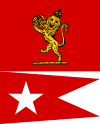 House Flag | |
Cunard-White Star Line, Ltd, was a British shipping line which existed between 1934 and 1949.[1]
History
The company was created to control the joint shipping assets of the Cunard Line and the White Star Line after both companies experienced financial difficulties during the Great Depression. Cunard White Star controlled a total of twenty-five ocean liners (with Cunard contributing fifteen ships and White Star ten). Both Cunard and White Star were in dire financial trouble, and were looking to complete enormous liners: White Star had Hull 844 –Oceanic – and Cunard had Hull 534, which would later become RMS Queen Mary. In 1933, the British government agreed to provide assistance to the two competitors on the condition that they merge their North Atlantic operations.[2] The agreement was completed on 30 December 1933. The merger took place on 10 May 1934, creating Cunard-White Star Limited. White Star contributed ten ships to the new company while Cunard contributed fifteen. Due to this arrangement, and since Hull 534 was Cunard's ship, Cunard owned 62% of the new company, with White Star owning the remaining 38%. White Star vessels flew the White Star flag over the Cunard flag while Cunard vessels flew the Cunard flag over the White Star flag.
Being in a better financial and operating state than White Star, Cunard began absorbing White Star assets and as a result, most of the White Star vessels were quickly disposed of or sent to the shipbreakers. White Star's Australia and New Zealand service ships were transferred to the Shaw, Savill & Albion Line in 1934 and RMS Olympic was retired and sold for scrap the following year, along with Cunard's RMS Mauretania. White Star's flagship RMS Majestic, the largest ship in the world until 1935, was sold in 1936.
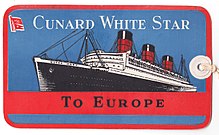
In 1947, Cunard acquired White Star’s 38% share in the company and on 31 December 1949 the company had dropped the White Star name and was renamed Cunard Line.[3] Both the Cunard and White Star house flags were flown on the company's liners at the time of the merger and thereafter. However, the Cunard flag was flown over the White Star flag on the last two White Star liners, MV Georgic and MV Britannic. Georgic was scrapped in 1956, while Britannic made the final Liverpool–New York crossing of any White Star vessel from New York on 25 November 1960, and returned to Liverpool for the final time before sailing under her own power to the ship breakers. She was the last White Star liner in existence, leaving the passenger tender SS Nomadic, which was also owned by the company until 1934, as the last White Star Line ship afloat.
Despite this, all Cunard Line ships flew both the Cunard and White Star Line house flags on their masts until late 1968. This was most likely because Nomadic remained in service with Cunard until 4 November 1968, and was sent to the breakers' yard, only to be bought for use as a floating restaurant. After this, the White Star flag was no longer flown, the White Star name was removed from Cunard operations and all remnants of both White Star Line and Cunard-White Star Line were retired.[4][5] Cunard operated as a separate entity until 1999, when it was fully acquired by Carnival Corporation.
Fleet
| Ship | Built | In service for Cunard-White Star Line | Tonnage | Image |
|---|---|---|---|---|
| Mauretania (1) | 1907 | 1934–35 | 31,950 GRT | 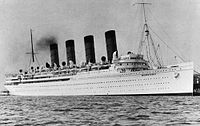
|
| Adriatic | 1907 | 1934-35 | 24,541 GRT | 
|
| Olympic | 1911 | 1934–35 | 46,439 GRT | 
|
| Ceramic | 1913 | 1934-42 | 18,400 GRT | 
|
| Berengaria | 1913 | 1934–38 | 51,950 GRT | 
|
| Homeric | 1913 | 1934–35 | 35,000 GRT | 
|
| Aquitania | 1914 | 1934–49 | 45,650 GRT | 
|
| Majestic | 1914 | 1934–36 | 56,551 GRT | 
|
| Scythia | 1921 | 1934–49 | 19,700 GRT | 
|
| Samaria | 1922 | 1934–49 | 19,700 GRT | 
|
| Laconia | 1922 | 1934–42 | 19,700 GRT | 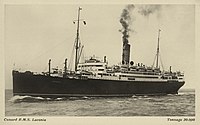
|
| Antonia | 1922 | 1934–42 | 13,900 GRT | 
|
| Ausonia | 1922 | 1934–42 | 13,900 GRT | 
|
| Lancastria | 1922 | 1934–40 | 16,250 GRT | 
|
| Franconia | 1922 | 1934–49 | 20,200 GRT | 
|
| Doric | 1923 | 1934–35 | 16,484 GRT | 
|
| Aurania | 1924 | 1934–42 | 14,000 GRT | 
|
| Carinthia | 1925 | 1934–40 | 20,200 GRT | 
|
| Ascania | 1925 | 1934–49 | 14,000 GRT | 
|
| Alaunia | 1925 | 1934–42 | 14,000 GRT | 
|
| Calgaric | 1927 | Never entered service (owned 1934) | 16,063 GRT | 
|
| Laurentic | 1927 | 1934–36 | 18,724 GRT | 
|
| Britannic | 1929 | 1934–49 | 26,943 GRT | 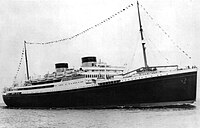
|
| Georgic | 1932 | 1934–49 | 27,759 GRT | 
|
| Queen Mary | 1936 | 1936–49 | 80,750 GRT | 
|
| Mauretania (2) | 1938 | 1938–49 | 35,738 GRT | 
|
| Queen Elizabeth | 1940 | 1940–49 | 83,650 GRT | 
|
| Media | 1947 | 1947–49 | 13,350 GRT | |
| Parthia | 1947 | 1947–49 | 13,350 GRT | 
|
| Caronia | 1949 | 1949 | 34,200 GRT | 
|
References
- OCLC 46449032. Retrieved 14 January 2012.
- ^ Chirnside 2004, p. 123
- OCLC 643663453.
- ^ Anderson 1964, p. 183
- ^ de Kerbrech 2009, p. 229
Works cited
- Anderson, Roy Claude (1964). White Star. Prescot: T. Stephenson & Sons Ltd. OCLC 3134809.
- Chirnside, Mark (2004). The Olympic-Class Ships. Stroud: ISBN 978-0-7524-2868-0.
- de Kerbrech, Richard P. (2009). Ships of the White Star Line. Hersham: Ian Allan Publishing. OCLC 298597975.
External links
- Cunard White Star History and Ephemera GG Archives
